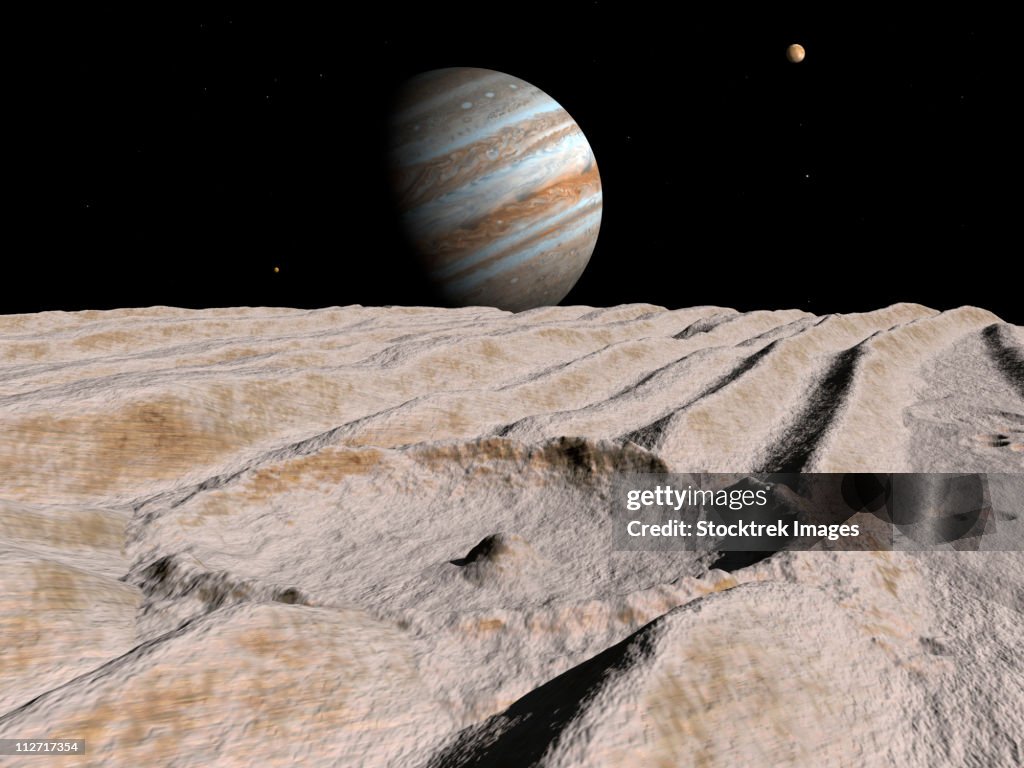Artist's concept of an impact crater on Jupiter's moon Ganymede, with Jupiter on the horizon. - stock illustration
Artist's concept of an impact crater on Ganymede, about 10 miles in diameter, dominates a scene otherwise defined by a dozen long ridges. In the middle of the crater is a central peak, formed when the energy of the impact liquefied the crust long enough for it to rebound upward and solidify once again. Immediately above the horizon, Jupiter is still a majestic spectacle, even at a distance of nearly three times that between the Earth and its moon. Much closer on the upper right is Ganymede's sister satellite Europa. At a distance of 307 thousand miles from this vantage point, Europa is only a quarter again as far as the Earth is from its moon. To the lower left of Jupiter at nearly a million miles is Jupiter's volcanic satellite Io. Jupiter's largest satellite Ganymede has a varying surface, some of which is characterized by rumpled bundles of ridges and grooves that run for hundreds of miles over a frozen surface of water09/14/2009ice. They probably formed long ago when tectonic forces pulled apart Ganymede's upper crust; similar sets of faults occur in rift zones on Earth, as in eastern Africa. Subsequent meteoritic impacts have peppered, and broken in places, the continuity of the running formations.

Get this image in a variety of framing options at Photos.com.
PURCHASE A LICENSE
All Royalty-Free licenses include global use rights, comprehensive protection, simple pricing with volume discounts available
€300.00
EUR
Getty ImagesArtists Concept Of An Impact Crater On Jupiters Moon Ganymede With Jupiter On The Horizon High-Res Vector Graphic Download premium, authentic Artist's concept of an impact crater on Jupiter's moon Ganymede, with Jupiter on the horizon. stock illustrations from 51łÔąĎÍř Explore similar high-resolution stock illustrations in our expansive visual catalogue.Product #:112717354
Download premium, authentic Artist's concept of an impact crater on Jupiter's moon Ganymede, with Jupiter on the horizon. stock illustrations from 51łÔąĎÍř Explore similar high-resolution stock illustrations in our expansive visual catalogue.Product #:112717354
 Download premium, authentic Artist's concept of an impact crater on Jupiter's moon Ganymede, with Jupiter on the horizon. stock illustrations from 51łÔąĎÍř Explore similar high-resolution stock illustrations in our expansive visual catalogue.Product #:112717354
Download premium, authentic Artist's concept of an impact crater on Jupiter's moon Ganymede, with Jupiter on the horizon. stock illustrations from 51łÔąĎÍř Explore similar high-resolution stock illustrations in our expansive visual catalogue.Product #:112717354€300€40
Getty Images
In stockDETAILS
Credit:
51łÔąĎÍř #:
112717354
License type:
Collection:
Stocktrek Images
Max file size:
4920 x 3690 px (16.40 x 12.30 in) - 300 dpi - 6 MB
Upload date:
Release info:
No release required
Categories:
- Ganymede - Planetary Moon,
- Io - Moon,
- Jupiter - Planet,
- Moon,
- Art Product,
- Astrobiology,
- Astronomy,
- At The Edge Of,
- Bumpy,
- Color Image,
- Crevasse,
- Digitally Generated Image,
- Europa - Planetary Moon,
- Extreme Terrain,
- Frozen,
- Futuristic,
- Horizon,
- Horizon Over Land,
- Horizontal,
- Ice,
- Illustration,
- Illustration Technique,
- Imagination,
- Impact,
- Land Feature,
- Landscape - Scenery,
- Meteor Crater,
- Mountain Ridge,
- No People,
- Outdoors,
- Outer Space,
- Permafrost,
- Planet - Space,
- Planetary Geology,
- Planetary Science,
- Scenics - Nature,
- Science,
- Solar System,
- Space Exploration,
- Surreal,
- Topography,
- Travel,